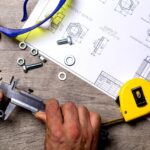Explore how 3D engineering transforms businesses through enhanced visualization, cost savings, faster development, and global collaboration.
The following is a guest post from my bloggy friend Taylor McKnight. Interested in having a guest post on my website? Click here for my guest post submission form.
Business Innovation Through 3D Engineering Technology and Design
Technology continually improves. As such, 3D engineering provides a powerful tool for engineers and architects. Engineers can now design and simulate projects with amazing precision and accuracy. There are numerous benefits gained when companies design with 3D engineering software, and there are other fields where the tool provides impact. It can change the ways that companies conduct business and innovate new designs.
What Is 3D Engineering?
3D engineering uses engineering tools that create three-dimensional models of systems or components. It’s cutting-edge technology that enables engineers to work in an environment where they can completely simulate their project. Industries that use the technology include manufacturing, entertainment, healthcare, and architecture. 3D engineering produces amazing results for each of these industries. Consider the following benefits that companies can realize using the technology.
Visualization That Appears Real
3D engineering can produce detailed images of projects or products. This makes it much easier for engineers to communicate complex ideas to stakeholders, clients, or other team members. When everyone involved has a clear understanding of what the end project will look like, it can speed up decisions to move forward on projects.
Faster Time to Market
Time to market is always a concern for businesses that compete in the world. Engineers can speed up the production cycle by creating prototypes, simulate much quicker, and testing various designs. Engineers can then identify and correct flaws in the early stages of a project. This can save companies a lot of time and money. It also helps the whole project process to run more smoothly and efficiently.
Company Savings
When companies integrate 3D engineering into their design and manufacturing processes, it saves money. One of the biggest savings comes from not having to detect and fix flaws well into the process. There are considerable expenses tied to building and testing physical prototypes. For instance, it takes additional raw materials to build a physical prototype. It also involves paying skilled labor for each assembly.
A company may also have to purchase or rent special tools and equipment, and add to that utilities and overhead costs of those facilities. The prototype, along with materials, may require transport to different locations. If there’s a third-party, there are likely additional expenses. Finally, there may be fees related to meeting industry standards and regulations.
Creative Product Development
3D Engineering enables engineers to explore new designs, which can result in creative solutions. Engineers can experience the magic of designing in a virtual world, which can enable them to go beyond thinking outside the box, and removing the box completely. Companies can then develop even more creative and innovative products. These are the actions that have set some companies apart from their competitors. 3D engineering and modeling allows engineers to create designs that might otherwise be impossible with older manufacturing methods.
Sustainability
3D engineering is more friendly for the environment because there’s less waste. Companies can also reduce overproduction and keep inventories low. 3D engineering projects can include materials that recycle such as plastics and polymers. There are some materials made from agricultural waste that are used. There are also certain modular designs that enable easy repairs and upgrades. These designs help to reduce the need for certain product replacements.
Customized Products
Mass production has long been the means through which companies create products. 3D engineering is the game-changer. In many industries mass production has given way to products that are more personalized to address client needs. 3D engineering provides customers with unique solutions and customized products. This results in satisfied customers and an increase in customer loyalty. Businesses and customers both win. With 3D engineering, engineers can create and refine every possible detail of a product to fit a client’s requirements. 3D printing brings designs to life by constructing precise physical prototypes.
Support for Decision Making
3D engineering removes a lot of the risk in product creation. Engineers can discover and fix flaws early in the design process. Reducing risk enables engineers, and everyone involved in the project, to make informed decisions that can cause costly errors down the line. Delays sometimes result in scraping projects, which are never good for a company’s bottom line. Company reputations can also suffer when projects fail.
Global Collaboration
3D engineering also enables collaboration of individuals and companies around the world. Remote work is on the rise around the globe, and 3D engineering is the perfect tool for connecting industries. Engineers can work on projects from anywhere in the world while collaborating on designs and participating in reviews. Companies can easily tap into a global talent pool. This often leads to new innovations and access to a complete array of new ideas and approaches.
Training and Education
3D is changing training and education across diverse fields. The educational upgrade is necessary if companies are to remain competitive. Professionals and students are learning to use 3D to better understand difficult concepts, and how to bring those concepts into reality. It’s a hands-on approach that is helping to prepare people for real design challenges the world will face now and in the future.
The Future of 3D Engineering
With the evolving speed of technology, it’s difficult to know completely where 3D engineering will lead. The one thing for certain is that 3D engineering holds some exciting possibilities. Technology will drive the change along with the growing needs of industries. Designs will continue to evolve and become even more creative. 3D printing technologies will also keep improving and enable engineers to create with a broader range of materials. This alone will likely spark industries to adopt the process as competition becomes keener.
Engineers will create complex designs with far greater ease. They’ll create these designs with other industry professionals in virtual spaces that results in more effective designs and improved communication between team members. The location of team members won’t present any issues, and simulation tools will continue to evolve allowing engineers to predict how a design can perform in numerous conditions.
There’s also the likelihood of merging IoT devices with innovative engineering designs that can lead to impressive results. Products will connect and become smarter while providing more data in real time. Industries that are likely to experience the change include healthcare, manufacturing, and infrastructure. Industries may also utilize blockchain technology more to protect manufacturing and design data. The integrity of supply chains, compliance, and safety will improve as a result.
As technology evolves, there will likely be an increase in augmented reality tools and wearable devices that will enhance an engineer’s design skills. The benefits are obvious. Engineers can improve the designs and correct any errors as they occur. Engineers will likely focus on creating environmentally friendly products along with design practices. 3D engineering will help make all these things a reality. Industries will transform how they conduct business. The future of 3D engineering will also arrive with challenges. The need for people with updated skills will increase along with the need to ensure that assets and designs are safe from theft.
Other Fields Impacted by 3D Engineering
Manufacturing is an industry that has transformed how the production process works. Additive manufacturing, also known as 3D printing, enables companies to create complex parts that would be impossible to design using typical manufacturing methods. Manufacturing companies that master 3D engineering processes are the ones that will stand apart from the competition.
Healthcare is another industry where 3D engineering continues to make a huge impact. This is especially true for the prosthetic and imaging healthcare fields. Surgeons and other professionals use 3D models today to practice and plan complex surgeries. They gain the experience and knowledge needed before entering an operation room. 3D engineering can also design and customize various implants and prosthetics for each patient’s unique requirements. This greatly improves patient outcomes and how fast they can recover.
The architecture and construction industries utilize 3D engineering when designing detailed and realistic models of structures and buildings. This enhances the design and planning stages, and allows clients and stakeholders to communicate at the highest levels. Add to this the fact both industries are exploring new construction methods with 3D printing. This can lead to the possibility of creating a revolution in building construction.
Conclusion
3D engineering is the tool that is changing the business world. There are benefits of 3D engineering that extend far beyond the boundaries of traditional design and manufacturing methods. Business across industries are realizing cost savings and reaping the rewards of advanced design. Technology won’t stop evolving, and 3D engineering will advance with it.
A whole new era of creativity and customized products are emerging across the business world. Businesses that embrace the new technology are the ones positioning themselves to meet future design and production challenges. Making 3D engineering a part of the manufacturing process is the key that will bring about major benefits for companies around the world.
Written by Taylor McKnight, Author for Osmose





